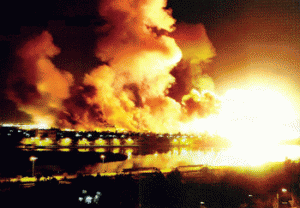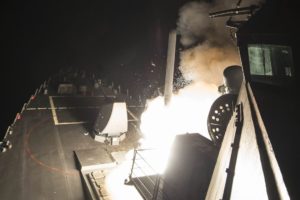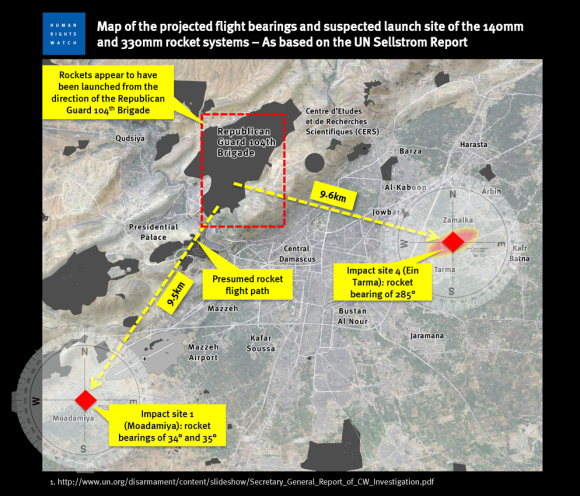Echoes of Iraq-WMD Fraud in Syria
Just as the West ignored signs in 2002-03 that anti-government Iraqis were fabricating WMD claims, evidence is being brushed aside that Syrian jihadists have ginned up chemical attacks, reports Robert Parry.

Featured image: At the start of the U.S. invasion of Iraq in 2003, President George W. Bush ordered the U.S. military to conduct a devastating aerial assault on Baghdad, known as “shock and awe.”
The New York Times and other Western media have learned few lessons from the Iraq War, including how the combination of a demonized foreign leader and well-funded “activists” committed to flooding the process with fake data can lead to dangerously false conclusions that perpetuate war.
What we have seen in Syria over the past six years parallels what occurred in Iraq in the run-up to the U.S.-led invasion in 2002-03. In both cases, there was evidence that the “system” was being gamed – by the Iraqi National Congress (INC) in pushing for the Iraq War and by pro-rebel “activists” promoting “regime change” in Syria – but those warnings were ignored. Instead, the flood of propagandistic claims overwhelmed what little skepticism there was in the West.
Regarding Iraq, the INC generated a surge of “defectors” who claimed to know where Saddam Hussein was concealing his WMD stockpiles and where his nuclear program was hidden. In Syria, we have seen something similar with dubious claims about chemical weapons attacks.
The Iraqi “defectors,” of course, were lying, and a little-noticed congressional study revealed that the CIA had correctly debunked some of the fakers but – because of the pro-invasion political pressure from George W. Bush’s White House and the U.S. mainstream media’s contempt for Saddam Hussein – other bogus claims were accepted as true. The result was catastrophic.
But the telltale signs of an INC disinformation campaign were there before the war. For instance, by early February 2003, as the final invasion plans were underway, the parade of Iraqi “walk-ins” was continuing. U.S. intelligence agencies had progressed up to “Source Eighteen,” one fellow who came to epitomize what some CIA analysts suspected was systematic INC coaching of sources.
As the CIA planned a debriefing of Source Eighteen, another Iraqi exile passed on word to the agency that an INC representative had told Source Eighteen to “deliver the act of a lifetime.” CIA analysts weren’t sure what to make of that piece of news since Iraqi exiles frequently badmouthed each other but the value of the warning soon became clear.
U.S. intelligence officers debriefed Source Eighteen the next day and discovered that “Source Eighteen was supposed to have a nuclear engineering background, but was unable to discuss advanced mathematics or physics and described types of ‘nuclear’ reactors that do not exist,” according to a Senate Intelligence Committee report on the Iraq War’s intelligence failures.
“Source Eighteen used the bathroom frequently, particularly when he appeared to be flustered by a line of questioning, suddenly remembering a new piece of information upon his return. During one such incident, Source Eighteen appeared to be reviewing notes,” the report said.
Not surprisingly, U.S. intelligence officers concluded that Source Eighteen was a fabricator. But the sludge of INC-connected disinformation kept oozing through the U.S. intelligence community, fouling the American intelligence product in part because there was little pressure from above demanding strict quality controls. Indeed, the opposite was true.
A more famous fake Iraqi defector earned the code name “Curve Ball” and provided German intelligence agencies details about Iraq’s alleged mobile facilities for producing agents for biological warfare.
Tyler Drumheller, then chief of the CIA’s European Division, said his office had issued repeated warnings about Curve Ball’s accounts.
“Everyone in the chain of command knew exactly what was happening,” Drumheller said. [Los Angeles Times, April 2, 2005]
Despite those objections and the lack of direct U.S. contact with Curve Ball, he earned a rating as “credible” or “very credible,” and his information became a core element of the Bush administration’s case for invading Iraq. Drawings of Curve Ball’s imaginary bio-weapons labs were a central feature of Secretary of State Colin Powell’s presentation to the U.N. on Feb. 5, 2003.
The Syrian Parallel
Regarding Syria, a similar mix of factors exists. The Obama administration’s advocacy for Syrian “regime change” and the hostility from many Western interest groups toward President Bashar al-Assad lowered the bar of skepticism enabling propaganda arms of Al Qaeda and its jihadist allies to have enormous success in selling dubious accusations about chemical attacks and other atrocities.

The Arleigh Burke-class guided-missile destroyer USS Ross fires a tomahawk land attack missile from the Mediterranean Sea toward Syria, April 7, 2017. (Navy photo by Petty Officer 3rd Class Robert S. Price)
As with the CIA analysts who tripped up a few of the Iraqi liars, some United Nations investigators have seen evidence of the trickery. For instance, they learned from townspeople of Al-Tamanah about how the rebels and allied “activists” staged a chlorine gas attack on the night of April 29-30, 2014, and then sold the false story to a credulous Western media and, initially, to the U.N. investigative team.
“Seven witnesses stated that frequent alerts [about an imminent chlorine weapons attack by the government] had been issued, but in fact no incidents with chemicals took place,” the U.N. report stated. “While people sought safety after the warnings, their homes were looted and rumours spread that the events were being staged. … [T]hey [these witnesses] had come forward to contest the wide-spread false media reports.”
Accounts from other people, who did allege that there had been a government chemical attack on Al-Tamanah, provided suspect evidence, including data from questionable sources, according to the U.N. report.
The report said,
“Three witnesses, who did not give any description of the incident on 29-30 April 2014, provided material of unknown source. One witness had second-hand knowledge of two of the five incidents in Al-Tamanah, but did not remember the exact dates. Later that witness provided a USB-stick with information of unknown origin, which was saved in separate folders according to the dates of all the five incidents mentioned by the FFM (the U.N.’s Fact-Finding Mission).
“Another witness provided the dates of all five incidents reading it from a piece of paper, but did not provide any testimony on the incident on 29-30 April 2014. The latter also provided a video titled ‘site where second barrel containing toxic chlorine gas was dropped tamanaa 30 April 14’”
Some other witnesses alleging a Syrian government attack offered curious claims about detecting the chlorine-infused “barrel bombs” based on how the device sounded in its descent.
The U.N. report said,
“The eyewitness, who stated to have been on the roof, said to have heard a helicopter and the ‘very loud’ sound of a falling barrel. Some interviewees had referred to a distinct whistling sound of barrels that contain chlorine as they fall. The witness statement could not be corroborated with any further information.”
However, the claim itself is absurd since it is inconceivable that anyone could detect a chlorine canister inside a “barrel bomb” by “a distinct whistling sound.”
The larger point, however, is that the jihadist rebels in Al-Tamanah and their propaganda teams, including relief workers and activists, appear to have organized a coordinated effort at deception complete with a fake video supplied to U.N. investigators and Western media outlets.
For instance, the Telegraph in London reported that
“Videos allegedly taken in Al-Tamanah … purport to show the impact sites of two chemical bombs. Activists said that one person had been killed and another 70 injured.”
The Telegraph also quoted supposed weapons expert Eliot Higgins, the founder of Bellingcat, as endorsing the report.
“Witnesses have consistently reported the use of helicopters to drop the chemical barrel bombs used,” said Higgins. “As it stands, around a dozen chemical barrel bomb attacks have been alleged in that region in the last three weeks.”
To finish up pointing the finger of guilt at the government, the Telegraph added that “The regime is the only party in the civil war that possesses helicopters” – a claim that also has been in dispute since the rebels had captured government air assets and had received substantial military assistance from Saudi Arabia, Turkey, the United States, Israel, Jordan and other countries.
The Al-Tamanah debunking received no mainstream media attention when the U.N. findings were issued in September 2016 because the U.N. report relied on rebel information to blame two other alleged chlorine attacks on the government and that got all the coverage. But the case should have raised red flags given the extent of the apparent deception.
If the seven townspeople were telling the truth, that would mean that the rebels and their allies issued fake attack warnings, produced propaganda videos to fool the West, and prepped “witnesses” with “evidence” to deceive investigators. Yet, no alarms went off about other rebel claims.
The Ghouta Incident
A more famous attack – with sarin gas on the Damascus suburb of Ghouta on Aug. 21, 2013, killing hundreds – was also eagerly blamed on the Assad regime, as The New York Times, Human Rights Watch, Higgins’s Bellingcat and many other Western outlets jumped to that conclusion despite the unlikely circumstances. Assad had just welcomed U.N. investigators to Damascus to examine chemical attacks that he was blaming on the rebels.
Assad also was facing a “red line” threat from President Obama warning him of possible U.S. military intervention if the Syrian government deployed chemical weapons. Why Assad and his military would choose such a moment to launch a deadly sarin attack, killing mostly civilians, made little sense.
But this became another rush to judgment in the West that brought the Obama administration to the verge of launching a devastating air attack on the Syrian military that might have helped Al Qaeda’s Syrian affiliate and/or the Islamic State win the war.

The controversial map developed by Human Rights Watch and embraced by the New York Times, supposedly showing the flight paths of two missiles from the Aug. 21, 2013 sarin attack intersecting at a Syrian military base. But the map was later disproved because only one rocket carried sarin (the one on the right) and it had only a fraction of the necessary range.
Eventually, however, the case blaming Assad for the 2013 sarin attack collapsed. An analysis by genuine weapons experts – Theodore A. Postol, a professor of science, technology and national security policy at the Massachusetts Institute of Technology, and Richard M. Lloyd, an analyst at the military contractor Tesla Laboratories – found that the missile that delivered the sarin had a very short range placing its likely firing position in rebel territory.
Later, reporting by journalist Seymour Hersh implicated Turkish intelligence working with jihadist rebels as the likely source of the sarin.
We also learned in 2016 that a message from the U.S. intelligence community had warned Obama how weak the evidence against Assad was. There was no “slam-dunk” proof, said Director of National Intelligence James Clapper. And Obama cited his rejection of the Washington militaristic “playbook” to bomb Syria as one of his proudest moments as President.
With this background, there should have been extreme skepticism when jihadists and their allies made new claims about the Syrian government engaging in chemical weapons attacks, just like the CIA should have recognized that the Iraqi National Congress’s production of some obviously phony “walk-ins” justified doubts about all of them.

Iraqi National Congress President Ahmed Chalabi
After the invasion of Iraq and the U.S. failure to find the promised WMD caches, INC leader Ahmed Chalabi congratulated his organization as “heroes in error” for its success in using falsehoods to help get the United States to invade.
But the West appears to have learned next to nothing from the Iraq deceptions – or arguably the lessons are being ignored out of a desire to continue the neoconservative “regime change” project for the Middle East.
Pressure to Confirm
U.N. investigators, who have been under intense pressure to confirm accusations against the Syrian government, continue to brush aside contrary evidence, such as testimony regarding the April 4 “sarin incident” at Khan Sheikhoun, that suggested a replay of the Al-Tamanah operation.
In a new U.N. report, testimony from two people, who were apparently considered reliable by investigators from the Organization for the Prohibition of Chemical Weapons, asserted that anti-government aircraft spotters issued no early-morning warning of a flight leaving the Syrian military airbase of Shayrat, contradicting claims from Al Qaeda’s allies inside Khan Sheikhoun who insisted that there had been such a warning.
If no warplanes left Shayrat airbase around dawn on April 4, then President Trump’s case for retaliating with 59 Tomahawk missiles launched against the base two days later would collapse. The U.S. strike reportedly killed several soldiers at the base and nine civilians, including four children, in nearby neighborhoods. It also risked inflicting death on Russians stationed at the base.
But the U.N. report accepts the version from the activists and rebels inside the Al Qaeda-controlled town and then goes on to endorse other rebel claims regarding alleged Syrian military chemical attacks on at least 20 other occasions.
The New York Times was mightily impressed with the U.N. report’s “unequivocal condemnation” of Assad’s regime and cited it as justification for Israeli warplanes bombing a Syrian military facility on Thursday. Rather than criticize Israel for attacking a neighboring country, the Times framed the action in a positive light as having “brought renewed attention to Syria’s chemical weapons.”
But the journalistic (and intelligence) point should have been that the West was fooled in Iraq by self-interested “activists” flooding the Times, the CIA and the world with fake information — so many bogus walk-ins that they overwhelmed whatever half-hearted process there was to weed out lies from truth. The Syrian “opposition” appears to have adopted a similar strategy in Syria with similar success.
Given the history, skepticism should be the rule in Syria, not credulity. Or, as President George W. Bush once said in a different context, “fool me once, shame on — shame on you. Fool me — you can’t get fooled again.”
Investigative reporter Robert Parry broke many of the Iran-Contra stories for The Associated Press and Newsweek in the 1980s. You can buy his latest book, America’s Stolen Narrative, either in print here or as an e-book (from Amazon and barnesandnoble.com).
Global Research announces the forthcoming release of the print edition of Mark Taliano’s Book, “Voices from Syria” which includes two additional chapters.
Taliano talks and listens to the people of Syria. He reveals the courage and resilience of a Nation and its people in their day to day lives, after more than six years of US-NATO sponsored terrorism and three years of US “peacemaking” airstrikes.
Mark Taliano combines years of research with on-the-ground observations to present an informed and well-documented analysis that refutes the mainstream media narratives on Syria.
Special Pre-Publication Offer
 **Pre-Order Special Offer: Voices from Syria (Ships mid-September)
**Pre-Order Special Offer: Voices from Syria (Ships mid-September)
ISBN: 978-0-9879389-1-6
Author: Mark Taliano
Year: 2017
Pages: 128 (Expanded edition: 2 new chapters)
List Price: $17.95
Special Price: $9.95

